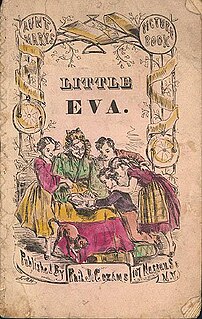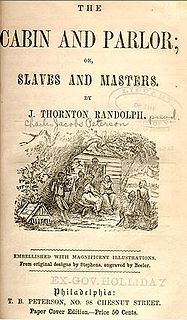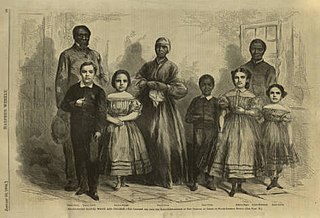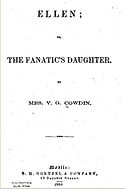
Uncle Tom's Cabin; or, Life Among the Lowly, is an anti-slavery novel by American author Harriet Beecher Stowe. Published in 1852, the novel had a profound effect on attitudes toward African Americans and slavery in the U.S. and is said to have "helped lay the groundwork for the Civil War".

Anti-Tom literature consists of the 19th century pro-slavery novels and other literary works written in response to Harriet Beecher Stowe's Uncle Tom's Cabin. Also called plantation literature, these writings were generally written by authors from the Southern United States. Books in the genre attempted to show either that slavery was beneficial to African Americans or that the evils of slavery as depicted in Stowe's book were overblown and incorrect.

Aunt Phillis's Cabin; or, Southern Life as It Is by Mary Henderson Eastman is a plantation fiction novel, and is perhaps the most read anti-Tom novel in American literature. It was published by Lippincott, Grambo & Co. of Philadelphia in 1852 as a response to Harriet Beecher Stowe's Uncle Tom's Cabin, published earlier that year. The novel sold 20,000–30,000 copies, far less han Stowe's novel, but still a strong commercial success and bestseller. Based on her growing up in Warrenton, Virginia, of an elite planter family, Eastman portrays plantation owners and slaves as mutually respectful, kind, and happy beings.

The Planter's Northern Bride is an 1854 novel written by Caroline Lee Hentz, in response to the publication of Uncle Tom's Cabin by Harriet Beecher Stowe in 1852.
Uncle Robin, in His Cabin in Virginia, and Tom Without One in Boston is an 1853 novel written by J.W. Page and released by J. W. Randolph Publishers of Richmond, Virginia.
Antifanaticism: A Tale of the South is an 1853 plantation fiction novel by Martha Haines Butt.

Little Eva: The Flower of the South is an Anti-Tom children's book by American writer Philip J. Cozans. Its publication date is unknown, although scholars have made some estimations. The book is about Little Eva, the daughter of a wealthy Alabama planter. She is kind toward slaves and teaches them how to read. On her ninth birthday, Little Eva nearly drowns, but she is rescued by a slave named Sam. Although her parents free Sam, he remains with the family because he loves them.
White Acre vs. Black Acre is an 1856 plantation fiction novel written by William M. Burwell.
Life at the South; or, "Uncle Tom's Cabin" As It Is is an 1852 plantation fiction novel written by William L.G. Smith.
The North and the South; or, Slavery and Its Contrasts is an 1852 plantation fiction novel by Caroline Rush, and among the first examples of the genre, alongside others such as Aunt Phillis's Cabin by Mary Henderson Eastman and Life at the South; or, "Uncle Tom's Cabin" As It Is by W.L.G. Smith, both of which were also released in 1852.
Frank Freeman's Barber Shop is an 1852 plantation fiction novel written by Baynard Rush Hall.

The Cabin and Parlor; or, Slaves and Masters is an 1852 novel by Charles Jacobs Peterson, writing under the pseudonym J. Thornton Randolph.
The Lofty and the Lowly, or Good in All and None All Good is a novel by Maria Jane McIntosh published by D. Appleton & Company in 1853. It was one of many anti-Tom novels published in response to Harriet Beecher Stowe's Uncle Tom's Cabin. The story is set is Georgia and tells of a plantation owner's efforts to avoid bankruptcy with the help of his loyal slave Daddy Cato. Their efforts are challenged by a northern usurer and devious northern capitalists. The book sold well across the United States upon release, making it one of the most successful anti-Tom novels in the middle 19th century.

Mr. Frank, the Underground Mail-Agent is an 1853 parody novel written by an unknown author credited as "Vidi".
Liberia; or, Mr. Peyton's Experiments is an 1853 novel by Sarah Josepha Hale, the author of the nursery rhyme "Mary Had a Little Lamb", who wrote the novel under the name of Sara J. Hale.
Tit for Tat is an 1856 novel written anonymously by "A Lady of New Orleans".
The Ebony Idol is a plantation literature novel first published in 1860 and written by G.M. Flanders.
Meredith Calhoun was a Planter and a newspaper editor in Grant Parish, Louisiana, known for his editorial activism on behalf of the Democratic Party.

White slave propaganda is the term given to publicity, especially photograph and woodcuts, and also novels, articles, and popular lectures, about mixed-race, white-looking slaves, which was used during and prior to the American Civil War to further the abolitionist cause and to raise money for the education of former slaves. The images included children with predominantly European-American features photographed alongside dark-skinned adult slaves with typically African-American features. It was intended to shock the viewing audiences with a reminder that slaves shared their humanity, and evidence that slaves did not belong in the category of the "Other".
Mary Mildred Williams, was an American mixed-race child born into slavery who became a symbol used by abolitionists before the Civil War to advance the cause of ending slavery in the U.S.







